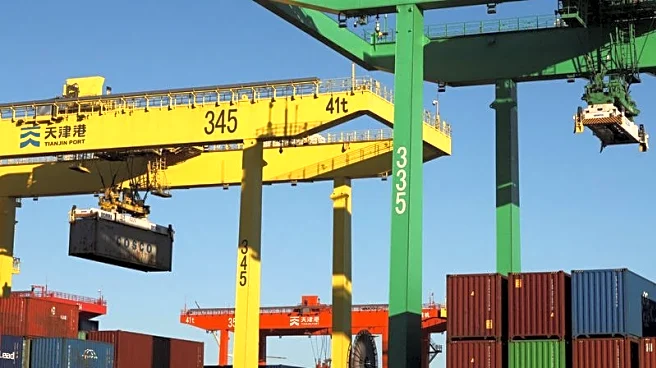What's Happening?
Developers in the U.S. are facing significant challenges due to fluctuating tariffs imposed by the Trump administration. These tariffs, which have been applied and removed with little notice, are affecting the cost of key building materials such as steel, aluminum, copper, and lumber. The unpredictability of these tariffs is making it difficult for construction industry leaders to predict prices, secure financing, and initiate new projects. For instance, GI Stone, a Chicago-based company, experienced delays and increased costs when tariffs were suddenly enforced on Canadian imports. Although temporary solutions like stockpiling inventory have helped mitigate immediate cost increases, the long-term impact is expected to result in higher rents and housing costs. The administration argues that tariffs encourage domestic sourcing and manufacturing, but developers like Sandya Dandamudi of GI Stone express concerns about the feasibility of relying solely on American-made products due to limited availability of certain materials.
Why It's Important?
The ongoing tariff situation is crucial as it directly impacts the construction industry, which is a significant component of the U.S. economy. The tariffs are contributing to increased costs for developers, potentially leading to higher housing prices and rents, which could exacerbate the existing housing shortage in cities like Chicago. Additionally, the uncertainty surrounding tariffs is affecting investor confidence and the ability to secure financing for new projects. This could slow down the development of new housing units, further straining the market. While the administration claims that tariffs will boost domestic manufacturing and job creation, the immediate effects seem to be more detrimental to the construction sector, which is already facing challenges due to high interest rates and borrowing costs.
What's Next?
The future of tariffs remains uncertain as the Trump administration has requested the U.S. Supreme Court to review a federal appellate court ruling that deemed the use of federal emergency powers to impose tariffs illegal. Developers and industry leaders are hoping for more stability in tariff policies to better plan and execute projects. The Federal Reserve's recent interest rate cut may provide some relief by lowering borrowing costs, but further cuts may be necessary to stimulate development. Industry experts are closely monitoring domestic producers' pricing strategies, as protection from foreign competition could lead to increased prices for U.S.-made materials, further complicating cost management for developers.
Beyond the Headlines
The fluctuating tariff policies highlight broader economic and political challenges, including the balance between protecting domestic industries and maintaining competitive pricing for imported goods. The situation underscores the complexity of trade policies and their far-reaching impact on various sectors. As developers navigate these challenges, there is a growing need for more predictable and stable trade policies to foster economic growth and address housing shortages. The ethical implications of prioritizing domestic production over global trade relationships also warrant consideration, as they affect international relations and economic stability.











